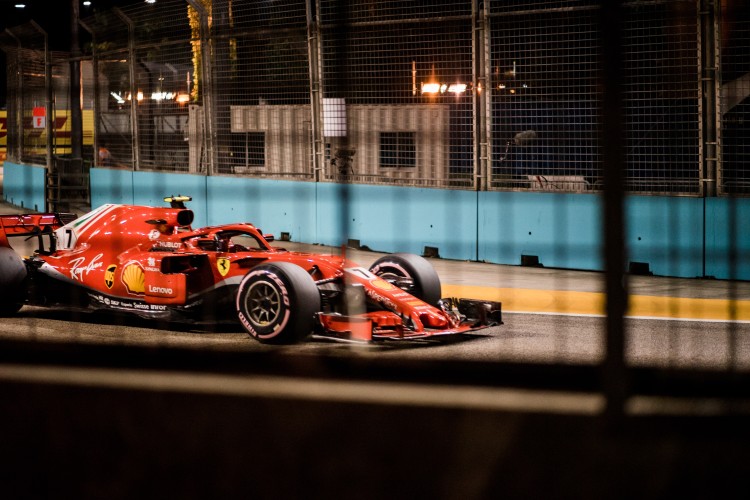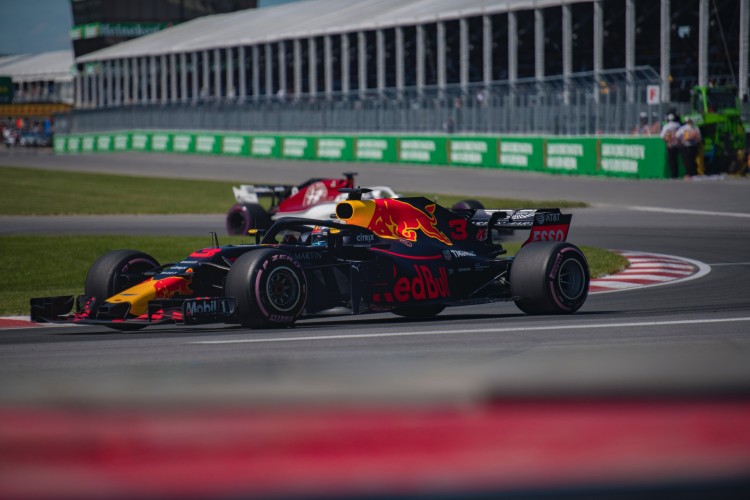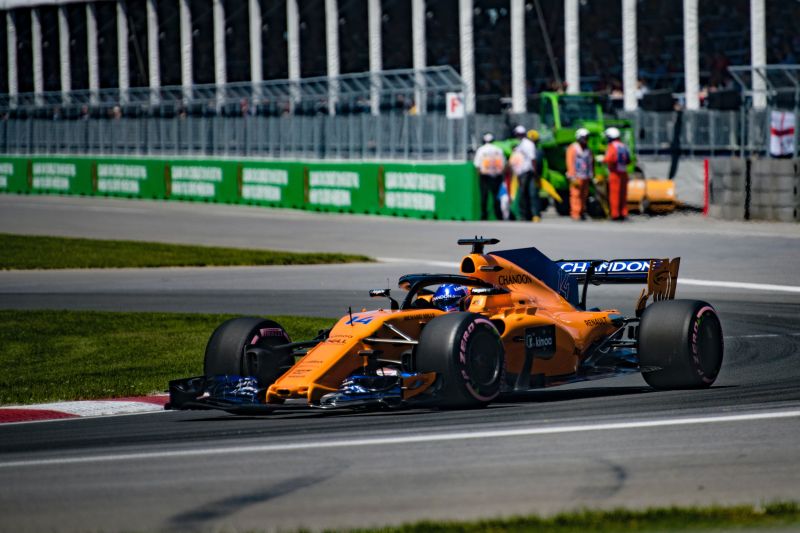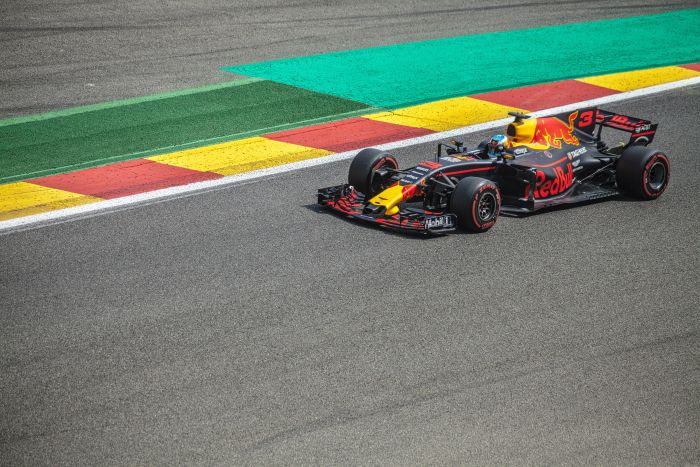
Have you ever been curious about how the pedals in Formula 1 race cars work? In normal cars with standard transmissions, the clutch, the brake, and the accelerator are arranged from left to right.
This was the sequence that racing cars followed at one point in time, although it no longer holds true for Formula 1 race cars quite some time ago. At this time, they only include 2 pedals.
So, how do Formula 1 pedals work? A potentiometer is installed behind the clutch pedal. The engine receives a signal when it’s being pressed, letting it know how much rev to produce. Because of this, using the throttle feels more like flipping a light switch than using a traditional throttle.
Since the Formula 1 World Championship was first to run in 1950, the pedals in the box were laid out in a manner that was comparable to how they were found in street-legal vehicles.
They were secured to the ground and were responsible for operating the accelerator, brakes, and clutch. In other models, such as the Maserati 250F F1 race vehicle of the 1950s, pedals were positioned slightly different ways, with the throttle being the center pedal and the brake placed on the right.
This was the case with the pedal arrangement. Aside from this peculiar configuration, the operation of the pedals was the same as it would be in any other race car; the only difference was that they were spaced further apart.
If you want to learn more about the pedals in Formula 1 cars and what they do, you should keep reading because there are more detailed explanations coming up.
Table of Contents
Clutch Pedals: Do They Exist in F1 Cars?
If you had the opportunity to go into any of the Formula 1 race vehicles which are used in today’s modern races, among the first features that you’d realize is that there are simply 2 pedals now instead of 3.
How come there are just 2 pedals? Every single one of today’s Formula One race vehicles is fitted with a semi–automatic gearbox, and this has been the case ever since Ferrari first unveiled them in 1989.
If you want to know What is Formula One? (DETAILED EXPLANATION), click here.
The clutch has been relocated from the floor to 2 paddles that are located on the back of the steering wheel, which has enabled this. Electronic impulses are transmitted from the paddles to the gears, which then cause them to shift higher or lower.
Therefore, Ferrari did away with not only the clutch pedal but also the gear shift altogether, rendering both of them useless.
Drive-by-wire technology is an additional intriguing development that has resulted in the throttle being disconnected from the powerplant by the traditional wires that were previously used to make the connection.
Note: A component known as a potentiometer can be found positioned behind the clutch pedal. Whenever the button is pushed, a signal is sent to the engine, which tells the engine how much rev it should be produced in response.
Because of this, manipulating the throttle feels less like manipulating a traditional throttle and more like manipulating a switch. The sensation is one of responsiveness rather than one of resistance.
If you want to know What Fuel Do F1 Cars Use? (INTERESTING FACTS!!!), click here.
Location of Clutch Pedals in Formula 1 Cars?

In Formula One racing, the clutch is controlled by a paddle on the steering wheel rather than a pedal.
It is typically a paddle that is located just on the rear of the steering wheel just below the paddle that is used to shift gears and is located on every side of the wheel.
If you want to know How Much Money Do Formula 1 Drivers Earn? (YOU WILL BE SURPRISED), click here.
In spite of the fact that there are 2 different paddles, the car only has one clutch that they control.
Why Are There Two Clutch Paddles in Formula One Cars?
The fact that Formula One vehicles have two clutch paddles enables drivers to have a greater degree of control over the clutch.
Having fully engaged 1 clutch paddle, they then press down on the second clutch paddle by a predetermined amount, which varies according to their biting point.
After they have released the 1st paddle, the clutch will immediately engage at the amount that they have chosen.
With 1 paddle completely engaged essentially prevents the vehicle from moving since it prevents the drive from being transmitted to the wheels.
However, the driver will identify the bite point prior to the race and will then be able to determine the exact amount of clutch inertia they will have to apply to reach that stage at the beginning of the race.
When either paddle is moved to its highest position, the clutch on the vehicle will engage at the greatest possible level.
To put it another way, in order to fully engage the clutch on the vehicle, one of the paddles must be drawn in all the way, while another paddle must be pulled in around 1/2 way.
Regardless of which paddle is being pulled in, the clutch will be “30% engaged” if 1 paddle is slowly pulled in 10% and another is pulled in 30%.
If you want to know How Fast Is A Formula 1 Car? (DETAILED EXPLANATION), click here.
Heel-and-Toeing
Known as heel-and-toeing, this method was developed by race car drivers in the 1950s and allows them to maintain a high engine rev limit when braking, allowing them to instantly re-accelerate when necessary.
The driver would retain their heel on the throttle as they angled the ball of their foot into the brake pedal. This allowed them to maintain as much of the engine’s throttle open as possible.
Every driver could alter the placement of the pedals to fit the dimensions of their feet as well as the manner in which he preferred to perform the heel-and-toeing method while driving.
As the 1960s progressed, there were no significant changes made to the method or the layout of the pedals. However, certain racing teams started punching holes in the pedals in order to decrease the car’s overall weight.
If you want to know What Is the Top Speed of an F1 Car? (AMAZING!!!), click here.
Titanium pedals were eventually introduced by manufacturers as a way to increase pedal durability while also reducing overall weight.
Note: Further on, the engineers of race cars had the idea that if they curved a front part of the car, this could even create the car more aerodynamic. As a result, the cockpits were even more cramped than they had been previously.
As a direct result of this, some drivers were forced to purchase footwear with a lower heel.
However, in order for the driver to feel the differences between the pedals, particularly between the brake and the throttle, the soles of the footwear needed to be constructed differently than standard soles in 2 ways:
- Users could not have broad soles because this would increase the risk of them reaching on the pedal next to them
- The sneakers need to be created as narrowly as practically possible.
Pedal Methods in Formula 1

Certain Formula 1 race vehicles still feature 3 pedals, but drivers only connect the right and middle pedals (which correspond to the brake and throttle, respectively) to their chassis.
Certain racing teams substituted a footstool for the clutch by installing a 3rd pedal or panel in the space previously occupied by the latter. Drivers will grab onto it in order to better brace themselves for sharp corners.
If you want to know Why Do F1 Cars Have Sidepods? (INTERESTING FACTS!!!), click here.
Even though the semi-automatic transmission was a game-changer for the cabin, this layout wasn’t actually a pioneering innovation at the time it was implemented.
The Lotus business experimented with the layout in 1971 when they were using a turbine to power their 56B model. The 56B did not require a clutch or a gearbox of any kind to operate.
The brake and throttle pedals on modern Formula 1 pedals have their own distinct shapes, and they have nothing in do with those seen on conventional cars. The size of the brake pedal is much more noticeable in comparison to the throttle.
This makes it possible to apply the highest amount of force while applying the brakes, which is necessary because it can take up to 4 times the gravity forces to put one of these to a complete stop.
The explanation for this is that Formula 1 rules demand that the driver deliver 100 percent of the braking effort, which is why the brakes on the cars are engineered to have no resistance at all. In addition, there is no requirement for smooth breaking when competing in a Formula 1 race.
Additionally, the pedals have higher sides that keep the driver’s foot from falling off of one pedal and mistakenly striking the next pedal.
And besides, the driver is nearly lying in the cockpit, and he is not in a position to glance down and observe exactly where his feet are going because he is unable to do so safely.
It should therefore come as no surprise that there has been a gradual shift of controls from the foot to the wheel in recent years.
Note: Between the years 1950 and 1960, drivers desired pedal positions that were somewhat close enough so that drivers could easily execute the heel-and-toe maneuver.
Left–foot braking is the favored driving technique of today’s Formula 1 drivers, hence the position of today’s pedals is determined by this style of driving.
The driver must apply the brakes with their left foot while simultaneously keeping the revs up by blipping the throttle using the right foot in order to utilize this strategy.
It achieves the same results as heel-and-toeing, but without the necessity of having to keep one foot on the clutch at all times.
Because drivers can now apply brakes with their left foot, there is no longer a requirement for the pedals to be situated in such close proximity to one another.
The driver will have greater leeway to move the feet from one pedal to another without the risk of accidentally hitting one of the pedals if the pedals are spaced further away.
Nevertheless, various riders have varying tastes and desires. Some racers appreciate the versatility of being able to adapt their cars to the specific requirements of the track they are competing on at any one moment.
If you want to know What Are The Best F1 Simulators? (ON THE MARKET), click here.
How Many Pedals Are There in Formula One Cars?

Formula One automobiles are equipped with only 2 pedals within the cockpit ahead of the driver’s feet, quite similar to the configuration of a regular automatic road vehicle.
On the left-hand side of the steering wheel is the brake, while on the right is the accelerator. Such pedals, on the other hand, are not at all like the kind you could see in a typical automobile designed for use on public roads.
The accelerator is the pedal located on the right-hand side of the steering wheel; depressing it will cause the engine to receive more fuel, which will cause the vehicle to move more quickly.
Since Formula One vehicles do not even have traction control, the driver needs to be exceedingly cautious and accurate with their right foot in order to avoid the back wheels from spinning.
If you want to know What Engines Do F1 Cars Use? (WHAT YOU DIDN’T KNOW!!!), click here.
The Braking Pedal
The brake pedal is located on the driver’s side of the vehicle, to the left. Because Formula One cars have such powerful brakes, the brake pedals on those cars are very hard and rigid.
When trying to get the brakes on their vehicle to function correctly, drivers frequently need to apply numerous pounds of pressure when pushing down on the pedals.
The typical automobile on the road and the race cars used in Formula One are very different from one another.
When operating a standard automobile, you need to apply the brakes in a measured and cautious way in order to make the vehicle to a complete stop as you progressively increase the force with which you push the brake pedal.
In Formula 1 cars, the drivers apply the brakes stronger and gently remove the foot from the brake as they approach a curve.
However, if an F1 driver presses down on the brake pedal with an excessive amount of force, they risk locking up the wheels, which is something that may both waste their time and create destruction to their tires.
They have therefore maintained a high level of control over the brakes despite the fact that they had to push exceedingly hard.
If you want to know What Is The Price Of A Formula 1 Car? (ALL PARTS CALCULATED), click here.
Conclusion
I hope you like this article about Formula 1 pedals and that you have learned something new.
